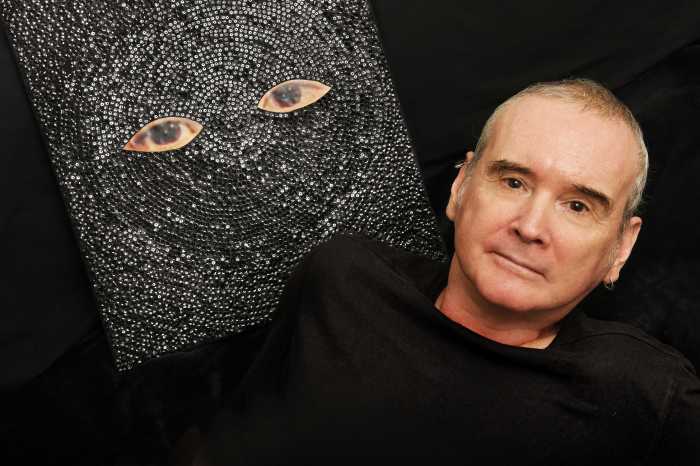BY JEFFREY CYPHERS WRIGHT
Representational art finds new ways to get funky with it
Parker, Barolini and Robleto
Cornelia Parker, Massimo Barolini and Dario Robleto
Through February 9
D’Amelio Terras
525 West 22nd Street
(212-352-9460; damelioterras.com)
Are We There Yet?
Don Porcella
Through February 2
Stux Gallery
530 West 25th Street
(212-352-1600; stuxgallery.com)
Whether it’s the pincushion of Charlotte Brontë or sheet music from the past, relics and reliquaries are fashionable this season. Some shows mine artifacts like Travis Somerville at Caren Golden Fine Art, while some create an imagined, or parallel past. Some recreate significant objects using unusual materials (like pipe cleaners). And some inhabit the present more successfully than others.
The doodlings and habitat of genius is the current subject of British artist Cornelia Parker. Parker is associated with Britart and its shock tactics and is known for dramatic installations. Her circular arrays such as “Thirty Pieces of Silver” (using silverware) implode and resurrect familiar tropes. She has said that she is interested in “killing things off and then resurrecting them, so that one set of references is negated as a new one takes its place.” In a three-person exhibition at D’Amelio Terras, Parker presents a news series of works called “Brontëan Abstracts.”
Focusing on the Brontë sisters, Parker uses an electron microscope to alter our perceptions. A pincushion magnified at least a dozen times, is recast as a bright blue field dotted with explosions of white. It’s so active, that at first I thought it was an aerial view of splashing swimmers in a pool. In another photograph redolent with the passage of time, dusty rose blotter paper boasts blobs of black ink, becoming a gorgeous exercise in non-objective aesthetics. By zeroing in so clearly on the minute, Cornelia has found a unique way to view actual things, and in doing so, she has found a new way to import meaning into abstracted art.
Another excursion into a version of the past is provided by Dario Roberto’s sculpture “Shaker Apothecary.” A beautiful cabinet done in authentic Shaker style presents rows of labeled drawers offering such mixed treasures as “Monster Mash/ Dead Sea Salt,” or “Do the Hand Jive/ Rose of Jericho.” I slid open a beckoning drawer and peeked in to see a pile of ground-up boneset.
In another work, Roberto presents fake album covers from the ’60s and ’70s in three glass cases. Each case has an overall label describing its collection. In “LAMB OF MAN,” there is humor, pathos and nihilism as well as strong graphics. Using construction paper and cardboard, the homemade look actually reinforces the folksy innocence and hope of the era, although the titles belie that happy notion. A familiar image, the stringy-haired woodcut hero of the musical “Godspell,” is undercut by a subtitle: “No One Is Waiting For You.” The query “Would you Follow the Heart of a Poet,” shows a Jesus-type shepherd leading a band of supplicants, including a lady in a wheelchair. The silhouette technique of the characters adds to the piquancy as well as the currency.
Spinning maddeningly, a bronze Buddhist in the Bodhisattva position occupies the last room of the gallery. “Revolutionary Buddha” by Massimo Barolini conflates prayer with destructive possibilities. Just as it implies both reverence and irreverence, it also represents an alchemical fusion of opposites such as still and agitated.
Irreverence is one of Don Porcella’s trump cards and he plays it with a refreshing air of optimism at his first solo show at Stux Gallery. His childishly reductivist paintings are dispatched with brute gusto. They can hit the mark visually as well as conceptually. “Solo Mission” depicts an astronaut zooming through the sky. Streaming out and propelling him is a diagonal slash of red, mustard and white daubs and drips — a perfect amalgam of abstraction and realism — done with cheekiness (and wide eyes). The encaustic on wood format adds weight and luster to the scores of small paintings.
Porcella is also known for working with pipe cleaners. These fuzzy, colorful units deflate the seriousness of art, causing a viewer to be charmed and disarmed. Probing further, they question our culture’s mightiest icons and in doing so, tweak our collective nose while maintaining sincerity. A hokey pipe cleaner eagle hangs from the sky. A Nike sneaker lies on its side still sheathing an amputated, bleeding foot. The presumably benign material is transformed into an agent of reversed expectations.
The most audacious part of an audacious show was a bunch of plastic bags tacked to the wall. Inside the bags were various gee-gaws made out of pipe cleaners. Cheese Yums were 99 cents. A little “Dealer” was offered. In his suit and red tie you wondered what kind of a dealer he was. Maybe all the artists need little action figures of dealers to play with, like Voodoo dolls to get into their dream gallery.
Here, Porcella crosses over from winning spoofery into an advanced portrayal of rituals and their attendant fetishes. This belief in things, both seen and unseen, is what lies at the root of art. We all want to have what we need to get what we want. And so we make good luck charms — and hey, sometimes they work.





































